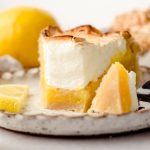Easy Lemon Meringue Pie Recipe
This classic lemon meringue pie recipe features a sweet and tart homemade lemon curd filling and a light and fluffy meringue topping. Bake in the oven to insure the filling sets and creates a beautiful and impressive dessert with clear, sturdy, defined layers.
Servings: 10 slices
Ingredients
LEMON CURD FILLING
- ½ recipe homemade pie crust
- 4 large egg yolks save the whites for the meringue (below)
- ¾ cup (150g) granulated sugar
- ¼ cup (40g) cornstarch
- zest of 3 lemons
- ½ cup (120mL) fresh lemon juice1
- ⅛ teaspoon salt
- ½ cup (113g) unsalted butter softened to room temperature and cut into 8 pieces2
MERINGUE
- 4 large egg whites
- ½ teaspoon cream of tartar
- ⅓ cup (67g) granulated sugar
- ⅛ teaspoon salt
Need to keep track of your ingredients?Check out my Printable Ingredient List!
Instructions
- Prepare my homemade pie crust recipe through step 6, or begin with a store-bought pie crust.½ recipe homemade pie crust
- When your pie crust is thoroughly chilled and ready to use, prepare a 9" pie plate with the pie crust. Adjust a rack in the oven to the lowest position, then preheat to 375°F (190°C).
- Partially blind bake your pie crust by fitting it with parchment paper and pie weights for 15 minutes, remove from the oven, remove parchment and pie weights, then bake for another 10 minutes.
- Remove partially blind baked pie crust from the oven, then reduce oven temperature to 350°F (177°C).
LEMON CURD FILLING
- Fill the bottom pot of a double boiler with 3-4" of water and turn heat to high. Bring the water to a boil, then reduce to a simmer. You may also use a pot with a heatproof bowl3 on top instead of a double boiler. Prepare the water the same.
- Combine the egg yolks, sugar, cornstarch, lemon zest, lemon juice, and salt in the top pot of the double boiler. Use a silicone whisk3 to continuously whisk the mixture as it cooks. It is important to keep the mixture moving so the eggs don't cook or curdle.4 large egg yolks, ¾ cup (150g) granulated sugar, ¼ cup (40g) cornstarch, zest of 3 lemons, ½ cup (120mL) fresh lemon juice1, ⅛ teaspoon salt
- Continue whisking the mixture until it becomes thick and foamy, approximately 10-15 minutes. If you want to check the temperature of the curd with an instant read thermometer to be safe, it should reach 160ºF (71ºC).
- Remove double boiler or top bowl from heat and whisk in butter pieces 2 at a time, adding the next pieces after previous pieces have mostly melted.½ cup (113g) unsalted butter
- When all of the butter has melted, pour the curd4 into the warm, partially blind baked pie crust. Set aside.
MERINGUE
- With a handheld mixer or a stand mixer fitted with the whisk attachment, beat the egg whites and cream of tartar together on medium speed for 1 minute, then increase to high speed until soft peaks form, about 4 more minutes.4 large egg whites, ½ teaspoon cream of tartar
- Add the sugar and salt, then continue beating on high speed until the mixture turns glossy and stiff peaks form, about 3-4 more minutes.⅓ cup (67g) granulated sugar, ⅛ teaspoon salt
- Spread the meringue directly on top of the warm lemon curd filling, using a large spatula or spoon to make decorative peaks. It is imperative that you spread the meringue all the way to the edges so that it touches the crust to prevent the meringue from shrinking.
- Bake lemon meringue pie for 20-25 minutes, until meringue is lightly browned. When the pie is done, remove it from the oven, place it on a wire rack, and allow it to cool at room temperature for about 1 hour before placing it in the refrigerator to chill for at least 3-4 hours before slicing and serving. Store leftovers in the refrigerator, keeping in mind lemon meringue pie is best served on day 1 as the meringue will start to wilt and weep after about 12 hours. See recipe note #4 about making this pie ahead of time. Lemon meringue pie does not freeze well.
Notes
- Fresh lemon juice: do not use bottled lemon juice. Use freshly squeezed lemon juice from the lemons that you zest (3 lemons will give you a little more than ½ cup of juice).
- Unsalted butter: you may use salted butter. Do not add additional salt.
- Bowl and whisk: do not use a metal bowl or a metal whisk, or you run the risk of your lemon curd tasting metallic.
- Warm curd: if you want to make your lemon curd ahead of time, see instructions in this post for how to store it until ready to use. You will want to warm up the lemon curd after refrigeration in a small saucepan in order to put warm lemon curd into the pie crust. This is crucial for the lemon curd and meringue to seal together.
Nutrition Disclosure
All nutritional values are approximate and provided to the reader as a courtesy. Changing ingredients and/or quantities will alter the estimated nutritional calculations.
Serving: 1slice | Calories: 255kcal | Carbohydrates: 31g | Protein: 3g | Fat: 14g | Saturated Fat: 7g | Polyunsaturated Fat: 1g | Monounsaturated Fat: 4g | Trans Fat: 0.4g | Cholesterol: 102mg | Sodium: 124mg | Potassium: 78mg | Fiber: 0.3g | Sugar: 22g | Vitamin A: 388IU | Vitamin C: 5mg | Calcium: 16mg | Iron: 1mg
